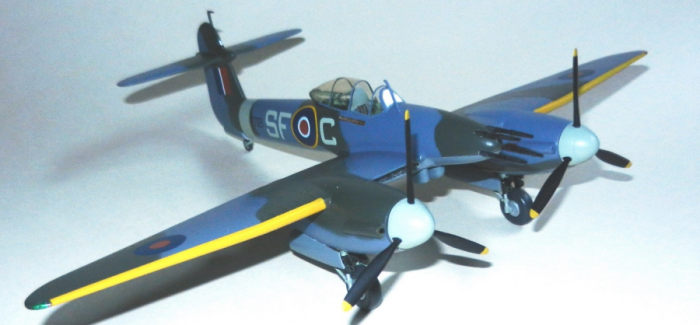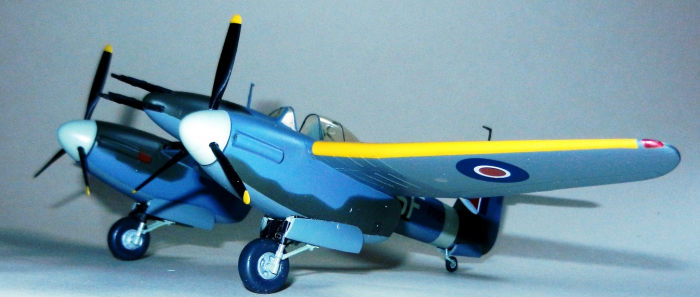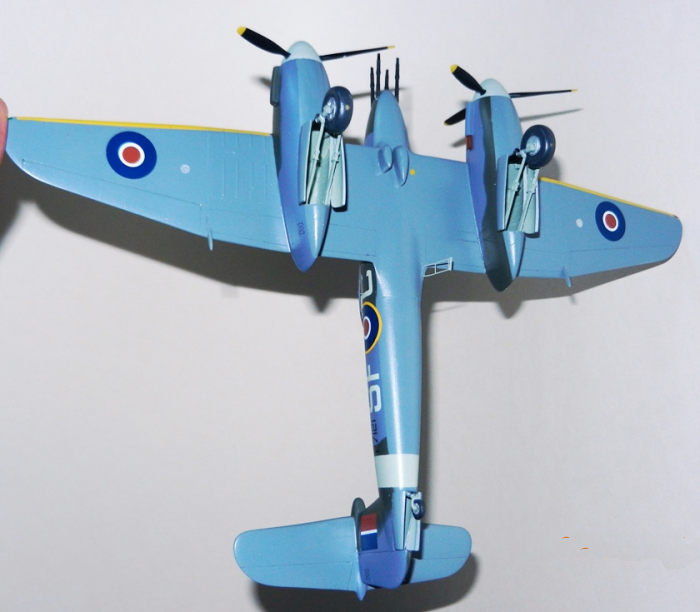
Classic Airframes 1/48 Whirlwind I
| KIT #: | 415 |
| PRICE: | $ |
| DECALS: | options |
| REVIEWER: | Pablo Calcaterra |
| NOTES: | Short run kit |

| HISTORY |
The Westland Whirlwind could have been one of the best British planes of WWII. The Peregrine engine was unreliable and suffered at high altitudes. Being the end of the line of the Kestrel and with Rolls Royce having issues manufacturing multiple types at the same time the decision was made to stop the development of the engine and only build 290 units. Because of this there were only 114 planes manufactured and this meant that only two squadrons saw service with this rare bird: 163 and 237 Sqn. No pilot became an ace with the type with only one pilot scoring more than 1 kill (Cliff Rudland DFC with 2 Whirlwind victories) though others became aces later on like Hap Kennedy RCAF.
After delays to order the plane and with the prototype being over engineered first flight took place on October 11 1938. The prototype was faster than the Spitfire below 10,000 ft and as fast between 10 and 20,000 ft. This first Whirlwind could outdive the Spit and above 360 mph (570 kmg/hr) it could out turn both the Spitfire I and the Hurricane. Regretfully ceiling was only 20,000 ft.
 Propellers
rotated in the same direction so it was hard to control on takeoff. During
landing the pilot had to use full power to keep the rudder and elevator
effective. Deliveries started in May 1939 with the last plane coming off the
line in December 1941.
Propellers
rotated in the same direction so it was hard to control on takeoff. During
landing the pilot had to use full power to keep the rudder and elevator
effective. Deliveries started in May 1939 with the last plane coming off the
line in December 1941.
Had the initial order been fulfilled on time there could have been several squadrons of this cannon armed fighter involved in the Battle of Britain. Another “What if…”
263 Sqn received their first Whirlwind on July 6, 1940 as it was being reformed in Scotland after the disaster in the Norwegian campaign. There were enough planes and pilots trained by the end of the year when in December the first operational sorties took place led by Sqn Ldr Eeles.
The first claim of a kill happened on January 12 when PO Stein in P6972 shot down a JU88 south west of the Scillies with the first confirmed one taking place on February 8 when an Arado 196 was shot down by FltLt Graham (shot down and killed in the action) and PO Crooks. By June 263 Sqn started to fly offensive sorties attacking enemy airfields in France (Warhead missions). September 1941 saw several pilots arriving to 263’s base. That was because 137Sqn was in the process of being formed. After taking part in ground and shipping attacks (E Boats and the famous Munsterland) and escort missions 263 traded their tired Whirlwinds with Typhoons in December 1943.
137 Sqn was operational with the type from November 1941 till June 1943 also converting to the Typhoon. The two squadrons suffered 9 KIA, 2 MIA, 1 KIFA, 5 POW and 4 badly injured while claiming 13 destroyed (Including 4 x Bf109 and 2 x 190!) and 18 damaged (plus multiple E boats and ground targets)
Whirlwind P7121 “Bellows Argentina No7” was completed on December 8
1941 and delivered to 137 Sqn on Feb 6 1942 with Sqn letters SF-C. It was
damaged on February 27, 1942. P7121 was involved in the one before last kill
of the Whirlwind on August 19 1942 while supporting Operation Jubilee (the
Canadian raid on Dieppe). She was being flown by P/OMike Bryan (with Sgt Des
Roberts in P7046) when they shot down Do 217 E-4 (F8+BN) of 5KG40. They were
vectored to a Do 217 fifty miles off Happisburgh. Roberts attacked first
from 250 yards and pieces of the bomber flew off. Roberts attacked in turn and hit the
Dornier in the underside of the fuselage and port engine. He fired from dead
astern and run out of ammo. He broke away and Roberts fired three more
bursts at close range. As he broke away the enemy started to smoke and four
members of the crew bailed out at 1,500 ft before stalling and diving into
the sea in flames. An air-sea rescue Walrus picked up Obt Wolf, the only
survivor. Finally on April 16 1943 P7121 crashed in Manston killing F/O John
Hadow when he was practicing dive bombing. Having completed several dives
over Goodwin Sands and when returning to base he tried one more dive but the
plane flicker over onto her back and dived into the ground 200 yards away
from B Flight dispersal. Hadow had arrived in the squadron a little time
before and was quite popular. P7121 had taken part in 90:40 operational
hours and flew a total of 325:35 hours.
and pieces of the bomber flew off. Roberts attacked in turn and hit the
Dornier in the underside of the fuselage and port engine. He fired from dead
astern and run out of ammo. He broke away and Roberts fired three more
bursts at close range. As he broke away the enemy started to smoke and four
members of the crew bailed out at 1,500 ft before stalling and diving into
the sea in flames. An air-sea rescue Walrus picked up Obt Wolf, the only
survivor. Finally on April 16 1943 P7121 crashed in Manston killing F/O John
Hadow when he was practicing dive bombing. Having completed several dives
over Goodwin Sands and when returning to base he tried one more dive but the
plane flicker over onto her back and dived into the ground 200 yards away
from B Flight dispersal. Hadow had arrived in the squadron a little time
before and was quite popular. P7121 had taken part in 90:40 operational
hours and flew a total of 325:35 hours.
Bellow Argentina were No1 P7055 – 137 Sqn – SOC, No?? P7057 – 137 Sqn – SOC, No2 P7116 – 263 Sqn – SOC, No3 P7117 – 263 Sqn – MIA (Cecil King), No4 P7118 – 137 Sqn – Crashed (Douglas Jovitt bailed out), No5 P7119 – 137 Sqn – Accident (Charles Mercer killed), No6 P7120 – 263 Sqn – Accident and SOC
The Fellowship of Bellows:
There was a strong Anglo-Argentine community living in Argentina in the 1940s with just over 50,000 people. Their contribution to the British war effort was significant in several aspects including supporting 164 Sqn (Firmes Volamos), almost 1,000 volunteers in the RCAF and RAF and the financial support thru the Fellowship of Bellows.
It all started as a joke in a bar in Buenos Aires. On October 14, 1940 the first open meeting took place at the English Club after the concept was publicized. The name Fellowship of Bellows was chosen because the aim was to support the Air Force (More Air Force). The Committee appointed Servants with the following names and responsibilities (always with British humour): High Wind (what he says blows), the Whirlwinds (secretaries always in a flap), Windfalls (the cashiers receiving the windfalls), Windbag (treasurer), Windlass (very easy on the air….lady members).
Funds raised were sent to the Ministry of Aircraft Production and the scheme was so successful that Brazil, Colombia, Venezuela, Ecuador, Nicaragua, El Salvador, Uruguay and other countries followed the Argentine example in short order.
Rules for members were as follows: anonymity, promotions based on the member’s contribution multiplied by the number of confirmed enemy planes shot down, everyone could join for a fee of 1 Peso among others.
 After
the initial payment the member became a Fellow with the rank of Puff (Soplito)
and a badge to be worn in her brooch or his buttonhole. An Official Booklet
was issued to the member where the contributions were tallied and promotion
to different ranks was achieved based on his/her contributions. Examples of
ranks were Gale (Vendaval) for 2,500 enemy aircraft confirmed shot down
since the day the member joined the Fellowship, Hurricane for 5,000 planes
and so on including Tornado, Tifon (Typhoon) and from 10,000 planes onwards
it was Order of the Bellows (with different “precious stones” based on
number of planes shot down)
After
the initial payment the member became a Fellow with the rank of Puff (Soplito)
and a badge to be worn in her brooch or his buttonhole. An Official Booklet
was issued to the member where the contributions were tallied and promotion
to different ranks was achieved based on his/her contributions. Examples of
ranks were Gale (Vendaval) for 2,500 enemy aircraft confirmed shot down
since the day the member joined the Fellowship, Hurricane for 5,000 planes
and so on including Tornado, Tifon (Typhoon) and from 10,000 planes onwards
it was Order of the Bellows (with different “precious stones” based on
number of planes shot down)
The first plane was purchased only after 4 months collecting money and was Whirlwind P7062 going to 263 Sqn. So important was the contribution to 263 Sqn that they adopted the nickname “Fellowship of the Bellows”. In 1942 contributions went to 137 Sqn followed by 193 Sqn in 1943 and 692 Sqn in 1944.
There were around 200,000 contributors and 56,000 were from Argentina, When the Fellowship was wound up the total collected was a little over 9 ½ million pesos (or GBP 600,000) of which Argentina contributed 1/3rd. Another 700,000 pesos were sent to the RAF Benevolent Fund and a much smaller fraction was destined to assist Argentine Scholars abroad. To put it in perspective the cost of a Spitfire was GBP 5,000. The final meeting (Deflation Party) took place in Plaza Hotel in Buenos Aires and around 1,000 Bellows from all over the world attended it.
| THE KIT |
There are 3 more reviews in MM including a much more detailed history of the type by Tom Cleaver.
Typical of Classic Airframes with photoetched and resin parts the plastic ones don’t have location pins. But with careful testing the kit can be built into a very nice replica that captures the beautiful lines of the Whirlwind.
| CONSTRUCTION |
 Construction
was very straightforward with the typical sanding of the excess of resin from
the pour stubs, the care that needs to be taken with the PE parts. Interior
parts were painted MM RAF interior green.
Construction
was very straightforward with the typical sanding of the excess of resin from
the pour stubs, the care that needs to be taken with the PE parts. Interior
parts were painted MM RAF interior green.
Fit of the plastic parts is very good with almost no putty needed. The only area that required a lot of attention was the screens for the radiators located at the border of attack: the PE parts, when folded, are taller than the room between top and bottom halves of the wings. Thus it is impossible to close them unless a lot of plastic is sanded away from the internal surfaces from the parts that make up the wings. Once that was solved the rest of the kit was very easy to assemble. With a small drill I opened up the intakes placed in front of the exhausts covers. I then glued the landing gear in place (not the easiest task…actually quite complicated)
| COLORS & MARKINGS |
Having decided to go for Bellows No7 (because it was donated by the Argentine citizens and had achieved a confirmed kill) I faced two challenges: getting a C with the correct size and shape and the Fellowship’s inscription under the cockpit.
 After
priming the kit with Vallejo light grey primer and yellow border of attack I
sprayed the spinners and the fuselage band with Modelmaster RAF sky. After
masking these I painted the undersides with plane with Model Master Acryl 4759.
Once the undersides and the band were masked with Tamiya tape and paper I
airbrushed the darker gray for the fuselage and wings using Model Master Acryl
4754. Finally I applied RAF Dark Green (ModelMaster) to complete the cammo.
Several layers of Future gave
a smooth surface for the decals.
After
priming the kit with Vallejo light grey primer and yellow border of attack I
sprayed the spinners and the fuselage band with Modelmaster RAF sky. After
masking these I painted the undersides with plane with Model Master Acryl 4759.
Once the undersides and the band were masked with Tamiya tape and paper I
airbrushed the darker gray for the fuselage and wings using Model Master Acryl
4754. Finally I applied RAF Dark Green (ModelMaster) to complete the cammo.
Several layers of Future gave
a smooth surface for the decals.
Most of the decals are the kits. As explained my challenge was the particularly oddly shaped “C” and the Bellows Argentina No7 text. With a lot of work I was able to cut the “P” supplied by CA and transform it into a “C”. The Bellows text was printed in white decal paper with different paint backgrounds (green and brown). It looks like the original paint scheme of P7121 was Brown/Green as pictures show a different colour under the fonts in an almost neat rectangle driving me to the conclusion that the text was masked when the grey was applied over the brown.
A coat of semi-gloss clear coat was applied to the entire plane. Navigation lights were painted in silver followed by Clear Red/Green. Antennas, spinners, propellers, guns and all final details including gunsight and windshield were added. The last part was the canopy with the PE structure.
| CONCLUSIONS |
A typical CA kit. Lots of work involved to get the parts to fit properly but a very satisfying finished product.
| REFERENCES |
263 and 137 Squadrons: The Whirlwind Years by Robert Bowater
The Westland Whirlwind by Philip Moyes
30 November 2021
Copyright ModelingMadness.com. All rights reserved. No reproduction in part or in whole without express permission.
If you would like your product reviewed fairly and fairly quickly, please contact the editor or see other details in the Note to Contributors.